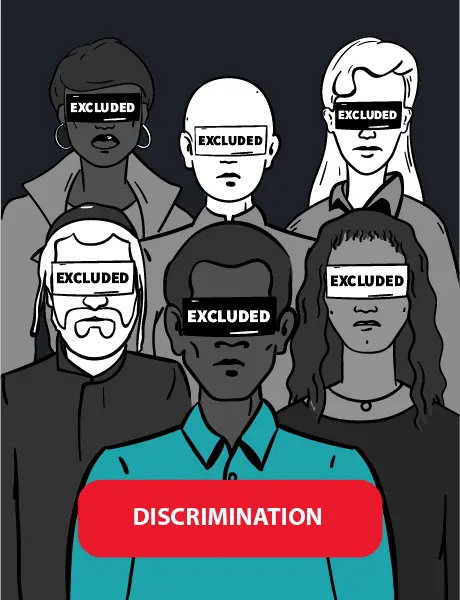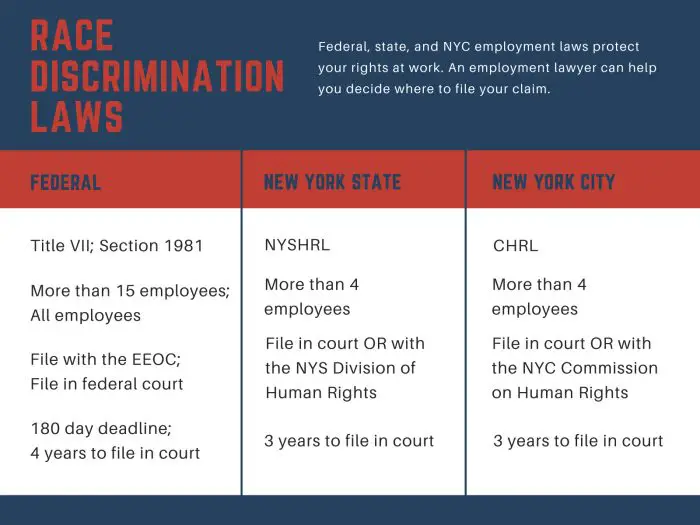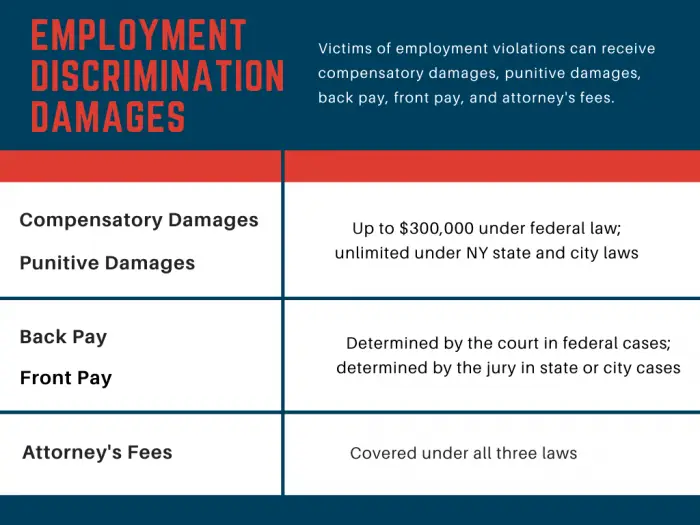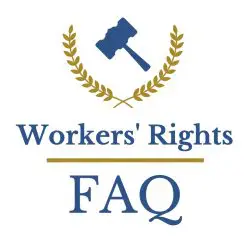Racial Discrimination in the Workplace
Protect Your Rights with a New York Discrimination Lawyer
Have you experienced racial discrimination at work? Mistreating a job applicant or employee because of their race violates the law.
Employment laws protect workers from race discrimination and race-based workplace harassment. Racial discrimination lawyers help victims of discrimination protect their rights.
Our guide walks through your rights under race discrimination laws and how to prove racial discrimination at work.
Contact New York discrimination lawyer Charles Joseph for a free consultation to protect your rights. Charles Joseph’s firm has recovered more than $140 million for clients. Reach out today for a free, confidential consultation.
- Know Your Rights
- Examples of Racial Discrimination
- Failure to Get Promoted
- Unequal Pay
- Race Stereotypes and Discrimination
- Discriminatory Policies
- Color Discrimination
- Racial Discrimination By Association
- Hostile Work Environments
- How to Prove Discrimination in the Workplace
- Legal Protection Against Retaliation
- How To File A Claim for Racial Discrimination
- Remedies for Racial Discrimination
Know Your Rights: What is Racial Discrimination?
Treating job applicants or employees unfavorably because of their race qualifies as race discrimination. This includes creating a hostile work environment through racial harassment.
It is illegal for an employer to make employment decisions based on your race.
Employers cannot make employment decisions based on your race. This includes decisions about hiring, firing, discipline, distribution of benefits, promotion, compensation, job training, or any other condition of employment.
Racial discrimination laws cover non-employees.
The law does not just protect employees. After October 11, 2019, New York State’s discrimination laws expanded to cover non-employees, such as domestic workers, independent contractors, consultants, vendors, and subcontractors.
An employment lawyer can help you determine whether NY race discrimination laws protect you.
If you believe that you have been the victim of race discrimination, you are protected under federal, state, and New York City racial discrimination laws.
“While most workplace racism is a drop more subtle, I have had my share of egregious overt cases. A black woman called me once after the owner of the company threatened her with a noose. This might have been a hard case to prove as there were no witnesses – but there were security cameras.
The owner tried to erase the recording, which caught him holding a noose up to my client. But he was unaware that a video technician had been there the night before, saw what happened on the tape, and made a copy, which he gave to my client. That enabled us to resolve the case for what it was truly worth. There are villains in these cases and there are heroes.”
Charles Joseph
Examples of Racial Discrimination in the Workplace
Race-Based Employment Decisions are Illegal
Making employment decisions – including hiring and firing – based on race or race stereotypes violates the law. This also includes unfavorable employment decisions because someone is associated with a person of a certain race.
Examples of Racial Discrimination:
- You apply for a job for which you have experience and excellent qualifications, but you are not hired because some of the company’s long-time clients are not comfortable dealing with African Americans.
- You are told that you are being laid off due to company cutbacks and reorganization, while white employees with the same job and less seniority keep their jobs.
- A coworker makes repeated offensive comments about your race. You report this to HR and the company fires you for “causing a problem.”
Failure To Promote Because Of Race Is Illegal
Racial discrimination laws also protect employees from not receiving promotions, including tenure, because of race or race stereotypes.
Examples of Racial Discrimination:
- You have worked as a low-level manager at a company for years and have had excellent performance reviews. Your responsibilities have increased over time, but your job classification and salary do not reflect this. Meanwhile, white colleagues have been promoted to mid and upper-level management to reflect their increased responsibilities.
- You have worked for your company for several years, receiving exemplary reviews and an employee-of-the-year award, yet every time you apply for a promotion, the position is filled by a less qualified person of a different race.
- After working as a teacher for several years, you apply for tenure. Your supervisor says a lot of Indian teachers have received tenure recently, so you’ll have to wait another year.
Race-Based Differences in Pay are Illegal
The law protects you from race-based differences in any form of compensation, including salary, overtime pay, bonuses, stock options, profit sharing, life insurance, and vacation or holiday pay.
Examples of Race-Based Pay Discrimination:
- You worked your way up to the position of regional manager. A regional manager of a different race with similar training and work experience was recently hired, and you learn that he will be paid more than you.
- You are a top salesperson for your company, but your employer reassigns you to a less desirable territory because it is a minority neighborhood, while a white employee with lower sales is given your territory and client base, enabling him or her to make much more in commissions than you. The law prohibits assigning primarily minorities to predominantly minority establishments or geographic areas.
- White employees at your company receive benefits, but people of color do not receive benefits, even though they work similar jobs.
Race Stereotypes and Discrimination
Employers cannot treat you unfavorably because of personal characteristics or stereotypes associated with race.
The law prohibits employment decisions based on stereotypes and assumptions about the abilities and traits of individuals from certain racial groups.
Employers cannot treat you unfavorably because of personal characteristics associated with race, including hair texture, skin color, or facial features.
Protected practices or characteristics can also include cultural dress, manner, or speech, as long as the practice or characteristic does not materially interfere with the ability to perform job duties. For example, your employer cannot refuse to promote you solely because you wear your hair in braids or dreadlocks.
Employers cannot excuse racially motivated decisions on the anticipated reactions of other employees or customers.
Employers cannot make racially motivated employment decisions with the excuse that the decision was driven by business concerns such as the effect on employee relations or the negative reaction of clients or customers.
Employers Cannot Segregate Employees By Race
If your employer physically isolates a particular group of employees away from other employees or customers because of race, that conduct could constitute race discrimination.
It is illegal to exclude minorities from certain positions or groups. It also violates the law to categorize employees or jobs so that certain jobs are generally held by minorities.
Policies With Discriminatory Effects
Unintentional racial discrimination in the workplace can also be illegal.
Job policies that appear neutral can be discriminatory if they disproportionately harm workers of certain races, as long as the policy is not job-related.
Examples of racial discrimination:
- An apparently neutral policy that requires all employees to have a high school degree may disproportionately exclude African Americans and Latinos, who have lower high school graduation rates. If a high school degree is not necessary to perform that particular job – such as a position that primarily involves physical labor – the policy could be discriminatory.
- A “no-beard” employment policy that applies to all workers without regard to race may not appear discriminatory, but it could be unlawful if the policy is not job-related and has a negative impact on the employment of African American men who have a predisposition to a skin condition that causes severe shaving bumps.
However, Section 1981 only prohibits intentional discrimination by your employer, and would not cover these situations.
Color Discrimination
Even though race and color overlap, they are not synonymous. What is discrimination based on color? And what is the difference between race and color discrimination?
Color discrimination occurs when a person is discriminated against based on the lightness, darkness, or another color characteristic of their skin. Unlike race, which is a socially defined category, color refers to skin tone. Discriminating against employees because of their skin color violates the law.
The law prohibits color discrimination against all persons, including Caucasians.
Racial Discrimination by Association
You do not have to be a member of a protected race to be the victim of race discrimination.
It is against the law to discriminate against someone because he or she is associated with someone of a different race.
Employers cannot treat you unfavorably because of:
- Your marriage to, or association with, someone of a different race.
- Your membership in, or association with, ethnic-based organizations or groups.
- Your attendance or participation in schools, places of worship, or other cultural practices generally associated with certain minority groups.
Racial discrimination can occur when the victim and the person who inflicted the discrimination are of the same race or color.
Race or color can never be a bona fide occupational qualification.
Hostile Work Environments Violate the Law
You can be the victim of racial discrimination in the workplace even when no employment decision is involved if race-based harassment has created a hostile work environment.
A hostile work environment can be created by:
- Words, such as jokes, racial slurs, or offensive or derogatory remarks about someone’s race or color.
- The display of images such as racist symbols like swastikas, confederate flags, nooses, or racist cartoons or drawings. Your employer may be responsible regardless of whether the offensive images are posted in a public area, displayed in a person’s office, or distributed via email.
Hostile Conduct Must Be More Than Petty Or Trivial
New York City has a lower standard for hostile conduct than federal or state law. Only conduct that is unwelcome or severe meets the threshold for a hostile workplace according to federal and state law.
Under federal law, if comments or acts are not offensive in the extreme, they constitute harassment only if they occur often enough to create an intimidating, hostile, or offensive work environment. However, a single incident such as a physical assault, use of “the N-word,” or hanging a noose, might be so threatening and insulting that it could rise to the level of harassment.
New York State recently lowered its standard so that after October 11, 2019, it no longer requires that discriminatory harassment be severe or pervasive.
New York City, however, defines hostile conduct as more than a “petty slight” or “trivial inconvenience.”
Victims Do Not Have To Be The Targets
It is a misconception that only the target of hostile comments can be the victim of a hostile work environment. You can be a victim even if you are not the person being targeted by the offensive behavior – and even if you are not a member of the targeted race.
If the offensive behavior is affecting your ability to do your job, you may have a claim.
The Offender Does Not Have To Be Your Boss
It is a misconception that only your boss can create a hostile work environment. Employers have a responsibility to prevent race discrimination.
While employers are generally liable for a supervisor’s behavior, they are also liable for the behavior of employees who are not in a position of authority over the victim if there have been complaints about the perpetrator or the perpetrator has committed acts against others.
If the company knew or should have known about the discrimination, they may be liable.
A co-worker, a supervisor in another area of the company, or even a non-employee, like a vendor, can be the perpetrator of discrimination.
How to Prove Racial Discrimination in the Workplace
Discrimination can happen in any workplace. If you think you are the victim of racial discrimination or a hostile work environment, there are several steps you can take right away.
- Start keeping notes of the discriminatory practices and/or harassment. Be specific in your details—write down the time and place of each incident, what was said and done, and who witnessed the actions.
- Keep doing a good job. Make copies of your job evaluations and any letters or memos that show that you are doing a good job at work.
- Seek support from friends and family, clergy, and, if helpful, a mental health professional. Harassment at work can be very stressful, and it is a difficult thing to face alone.
- Report the incident in writing to your supervisor and human resources department. Tell them about the behavior and the steps you have taken to address it.
- Check your company’s employee handbook. If your employer has a harassment policy in place, follow it.
- Preserve any information such as inappropriate texts, pictures, or voicemails sent to you.
- Put all of your complaints in writing, and keep copies at home.
In addition to taking these steps, racial discrimination lawyers can help victims of racial discrimination protect their rights. Contact workplace discrimination lawyer Charles Joseph for a free consultation.
Retaliation is Illegal
If you complain about race discrimination, it is illegal for your employer to take any action against you.
It is illegal for employers to retaliate against applicants or employees who complain about discrimination on the job, file a charge with the Equal Employment Opportunity Commission (EEOC) or any state or city agency, or participate––including being a witness––in an employment discrimination proceeding, such as an investigation or lawsuit.
You Are Protected From Retaliation Even If There Was No Discrimination
As long as you had a good faith and reasonable belief that discrimination or harassment occurred, your employer is barred from taking any action against you for speaking out or participating in any investigation or proceeding. It does not matter if an agency or court determines that there was no discrimination.
If you speak out about discrimination and harassment in your workplace, the law protects you from retaliation.
How to File a Claim For Race Discrimination
If you choose to file a claim for race discrimination, you have several options. You can file a complaint with the U.S. Equal Employment Opportunity Commission (EEOC), which handles violations of federal law. The New York State Division of Human Rights handles NYSHRL violations, and the New York City Commission on Human Rights is responsible for CHRL violations.
If your claim falls under multiple racial discrimination laws, the three agencies have what is called a “work-sharing agreement,” which means they cooperate with each other to process your claims. There is no need to file a claim with each agency. You simply need to indicate that you want your claim “cross-filed” with the other agencies.
Learn how to file a discrimination claim, how to file an EEOC complaint, or contact a New York racial discrimination attorney for help.
Comparing Racial Discrimination Laws
Racial discrimination attorneys can file suit under federal, New York state, and New York City racial discrimination laws. Contact racial discrimination attorney Charles Joseph for a free consultation.
Legal Remedies for Racial Discrimination
Racial discrimination laws provide financial remedies for employees who faced workplace discrimination. This includes damages, back pay, and other financial settlements. A New York racial discrimination attorney can help file your claim.
- Back Pay: Back pay compensates victims of race discrimination for the wages, bonuses, and benefits lost due to discrimination.
- Reinstatement: The court can order your employer to rehire you or to give you a promotion if you were wrongly terminated or denied promotion for discriminatory reasons.
- Front Pay: Front pay is a monetary amount calculated by the court to help the victim of discrimination return to the level of pay he or she earned before the discrimination. It includes lost wages and benefits.
- Compensatory Damages: Compensatory damages cover the victim’s out-of-pocket expenses, like therapy, lost wages, and the cost of finding a new job. It also includes emotional pain and suffering.
- Punitive Damages: Punitive damages punish the employer. New York City provides broad punitive damages provisions if the employer was negligent, reckless, or consciously disregarded your rights.
- Attorneys’ Fees and Costs: If the court finds that discrimination occurred, your employer may be required to pay all of your attorney fees and court costs.
Potential Damages In A Racial Discrimination Lawsuit
Victims of racial discrimination can also receive emotional distress damages in a lawsuit.
Racial discrimination laws protect employees, and racial discrimination lawyers can help determine your potential damages. Charles Joseph has over twenty years of experience as a racial discrimination attorney. Call Charles Joseph today for a free, confidential consultation.



